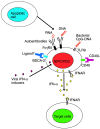A pivotal role for the natural interferon alpha-producing cells (plasmacytoid dendritic cells) in the pathogenesis of lupus
- PMID: 11748288
- PMCID: PMC2193578
- DOI: 10.1084/jem.194.12.f59
A pivotal role for the natural interferon alpha-producing cells (plasmacytoid dendritic cells) in the pathogenesis of lupus
Figures

Comment on
-
BDCA-2, a novel plasmacytoid dendritic cell-specific type II C-type lectin, mediates antigen capture and is a potent inhibitor of interferon alpha/beta induction.J Exp Med. 2001 Dec 17;194(12):1823-34. doi: 10.1084/jem.194.12.1823. J Exp Med. 2001. PMID: 11748283 Free PMC article.
References
-
- Bogdan, C. 2000. The function of type I interferons in antimicrobial immunity. Curr. Opin. Immunol. 12:419–424. - PubMed
-
- Akbar, A.N., J.M. Lord, and M. Salmon. 2000. IFN-α and IFN-β: a link between immune memory and chronic inflammation. Immunol. Today. 21:337–342. - PubMed
-
- Sinigaglia, F., D. D'Ambrosio, P. Panina-Bordignon, and L. Rogge. 1999. Regulation of the IL-12/IL-12R axis: a critical step in T-helper cell differentiation and effector function. Immunol. Rev. 170:65–72. - PubMed
-
- Ruuth, K., L. Carlsson, B. Hallberg, and E. Lundgren. 2001. Interferon-α promotes survival of human primary B-lymphocytes via phosphatidylinositol 3-kinase. Biochem. Biophys. Res. Commun. 284:583–586. - PubMed
Publication types
MeSH terms
Substances
LinkOut - more resources
Full Text Sources
Other Literature Sources

